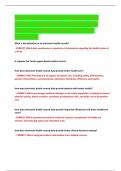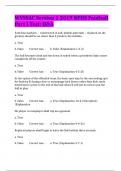MHA 705 Exam 3|LATEST VERSION |NEW
UPDATE |GUARANTEED PASS|2024-2025
|BEST STUDYING MATERIAL WITH 100+
QUESTIONS
What is the definition of an electronic health records?
- CORRECT ANS-A data warehouse or repository of information regarding the health status of
a client.
It replaces the former paper-based medical record.
How does electronic health records help provide better health care?
- CORRECT ANS-They improve all aspects of patient care, including safety, effectiveness,
patient-centeredness, communication, education, timeliness, efficiency, and equity.
How does electronic health records help provide patients with better health?
- CORRECT ANS-It encourages healthier lifestyles in the entire population, including increased
physical activity, better nutrition, avoidance of behavioral risks, and wider use of preventive
care.
How does electronic health records help provide improved efficiencies and lower healthcare
costs?
- CORRECT ANS-It promotes preventive medicine, improve coordination of healthcare
services, and reducing waste and redundant tests.
How does electronic health records help provide better clinical decisions making?
- CORRECT ANS-It integrates patient information from multiple sources.
,What is the first step of ownership?
- CORRECT ANS-It is typically a vendor selection process.
Despite the challenges, the future of electronic health records is what?
- CORRECT ANS-An exciting one for patients and clinicians.
Benefits may be realized by stand-alone electronic health records, but the most significant
transformation will come from what?
- CORRECT ANS-Interoperability that is realized between systems.
There is a ______________ available pointing to the benefits of an electronic health record. -
CORRECT ANS-Wealth of descriptive data
Healthcare professionals must stay ___________ in the evolution of electronic health records
and _________________.
- CORRECT ANS-evolved; help shape their direction.
Stage 1 criteria of electronic health records is what?
- CORRECT ANS-Meaningful use criteria; focus on data capture and sharing.
Stage 2 (by 2014) criteria of an electronic health record is what?
- CORRECT ANS-Advance several clinical processes and promote health information exchange
(HIE) and more patient controlled data.
Stage 3 (by 2016) criteria of the electronic health record is what?
- CORRECT ANS-Focus on improved outcomes for individuals and populations and on patient
self-managements tools.
Electronic health records is the systematic documentation of what?
, - CORRECT ANS-A clients health status and health care in a secured digital format.
It can be processed, stored, transmitted, and accessed by authorized interdisciplinary
professionals for the purpose of supporting efficient, high-quality health care across the
clients healthcare continuum.
What is the essential component of Health information and data?
- CORRECT ANS-The patient data required to make sound clinical decisions, including
demographics, medical and nursing diagnoses, medication lists, allergies, and test results.
What is the essential component of results management?
- CORRECT ANS-The ability to manage results of all types electronically, including laboratory
and radiology procedure reports, both current and historical.
What is the essential component of Order entry management?
- CORRECT ANS-The ability for a clinician to enter medication and other care orders directly
into a computer, including laboratory, microbiology, pathology, radiology, nursing, supply
orders, ancillary services, and consults.
What is the essential component of Decision support?
- CORRECT ANS-Computer reminders and alerts to improve the diagnosis and care of a
patient.
What is the essential component of Electronic communication and connectivity?
- CORRECT ANS-The online communication among healthcare team members, their care
partners, and patients, including email, web messaging, and an integrated health record
within and across settings, institutions, and telemedicine.
What is the essential component of patient support?
- CORRECT ANS-Patient education and self-monitoring tools, including interactive computer-
based patient education, home telemonitoring, and telehealth systems.





